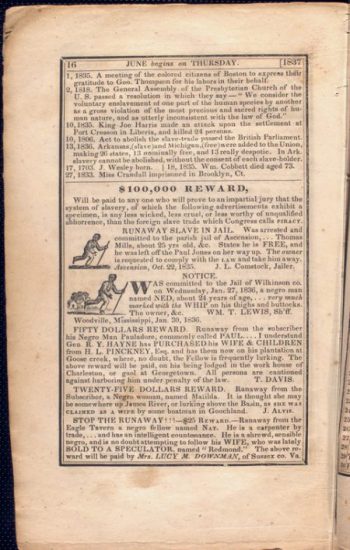This exhibits artifact represents the $100,00 Reward ad, published by Webster & Southard in 1837, who also published The American Anti-Slavery Almanac between the years of 1836 and 1844, which was created to inform readers of the highly alarming situation of racism and inequality of the slave system in America. [8 ] The advertisement displays a timeline of events that relate to the reward listed below or have taken place before or around the time of releasing the ad’s request. It proceeds to announce a reward of $100,000 to anyone who can prove to an unbiased jury that the slavery being advertised in this text is not as morally wrong compared to the inhumane slave trade system Congress deems as piracy. The following advertisements that were listed under the $100,000 reward were what was being questioned as not morally wrong, where people were being offered about a twenty-five dollar reward if a specific slave (a person of African descent) were to be returned to their owners and it demonstrates descriptions of the enslaved people and where they may be as some families were ripped apart and separated to different plantations where they were forced to work. This issued ad was one of the many that people were familiar with during this period of the American slavery system, as many were used to persuade civilians to seek out runaway slaves with a reward of a certain amount of money, which could range from a small amount of money to a large sum as demonstrated on this ad. It exemplifies the lack of empathy society had for people of African descent through their flawed mentality that the enslavement of another race due to their skin color is proper or reasonably justified because of white superiority.

Slavery was an abomination to society, and many innocent lives who were held captive without their freedom or rights were tortured, killed, abused, and treated worse than animals. It began many centuries ago, starting before the 1500s, when “the first slaves were captured and transported to the New World,” which was America, as they needed people to do the labor as they were building the “New World.” [2] Centuries later, as the demands of America increased with plantation labor, so did the demand for workers. Slavery created many problems in society through discrimination as the enslaved people were seen as profitable, “In this sense, the South coerced enslaved people to create a cotton empire…Slavery was more than a moral disgrace’ it was a profit-making system built upon forced labor exploitation, a vicious form of racial capitalism.” [7] This shows that the enslaved weren’t seen as human, only as money and power for the wealthy white Americans. Yet, there were approximately “11 million Africans enslaved” alive. [2] However, many were captured and did not survive the journey due to poor treatment, starvation, diseases, etc. Additionally, the tortures they had to go through were inhumane, as they’d experience a tremendous amount of suffering on their journey to America by laying “back to belly in the holds of the slave ships in each other’s excrement and urine together, sometimes died together, and our lifeless bodies were thrown overboard together.” [1] When they reached America, not only were their bodies to be exploited, assaulted, killed, traumatized, and disrespected, but so were their integrity and spirit.

Many enslaved women and their bodies were mistreated and used by their owners or whoever had the authority to do so. They were often used to be bred to provide future enslaved children, but “slave women were largely powerless to protect one another, and their bodies were never given the respect afforded White women.” [2] Enslaved people were not cared for, and their lives were considered worthless as their owners only cared about their business profits, which “depended on putting enslaved people through exhausting journeys in squalid conditions, and as the urgency of moving more enslaved people into markets for sale escalated with increased demand…through Tennessee that slaves were dying on the road”. [3] This expresses the cruelty of society during this period of enslavement, where many of the enslaved lives were treated as worthless. Their suffrage continued for decades but wouldn’t end until after the Civil War in 1865. [7] Furthermore, the advertisement that was published to the public rewards anyone who can go before and inform an unbiased jury that the slavery described in the ad is not as morally wrong as the slave trade system that Congress deems as piracy. Thus, enslaved people had to endure an excruciating amount of pain, lack of freedom and fundamental human rights, and inequality in the 1800s as many people were trying to rebel against the law through their beliefs that what was occurring was not as inhumane as the slave trade system.
All pictures obtained from The New York Public Library, Digital Collections.
[1] Berlin, Ira. 2004. “American Slavery in History and Memory and the Search for Social Justice.” Journal of American History 90 (4): 1251–68. doi:10.2307/3660347.
[2] Gay, Patricia L. 1999. “Slavery as a Sexual Atrocity.” Sexual Addiction & Compulsivity 6 (1): 5. doi:10.1080/10720169908400174
[3] Rothman, Joshua D. 2022. “The American Life of Jourdan Saunders, Slave Trader.” Journal of Southern History 88 (2): 227–56. doi:10.1353/soh.2022.0054.
[4] Schomburg Center for Research in Black Culture, Manuscripts, Archives and Rare Books Division, The New York Public Library. “$100,000 Reward.” New York Public Library Digital Collections. Accessed May 16, 2024 https://digitalcollections.nypl.org/items/510d47da 7586-a3d9-e040-e00a18064a99
[5]Schomburg Center for Research in Black Culture, Photographs and Prints Division, The New York Public Library. “Runaway slave advertisement” New York Public Library Digital Collections. Accessed May 16, 2024. https://digitalcollections.nypl.org/items/510d47db-bd19-a3d9-e040-e00a18064a99
[6] Schomburg Center for Research in Black Culture, Photographs and Prints Division, The New York Public Library. “View of chained African slaves in cargo hold of slave ship, measuring three feet and three inches high” New York Public Library Digital Collections. Accessed May 16, 2024. https://digitalcollections.nypl.org/items/cd25e5e0-2658-0132-a7fd-58d385a7b928
[7] SHI, DAVID E. America: A narrative history. S.l.: W W NORTON, 2022.
[8] The Anti-Slavery Almanac, n.d. https://www.teachushistory.org/second-great-awakening-age-reform/resources/anti-slavery-almanac#:~:text=The%20Anti%E2%88%92Slavery%20Almanac%20was,evils%20of%20slavery%20and%20racism.
